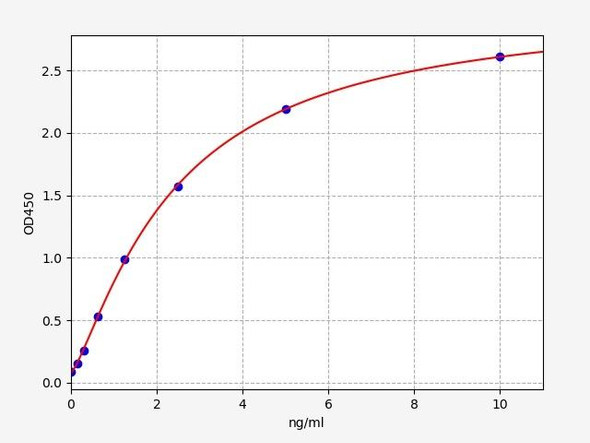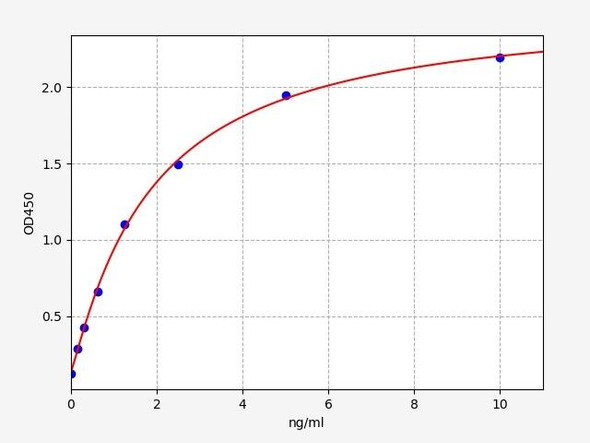Mouse Endorepellin/Perlecan ELISA Kit (MOFI00250)
- SKU:
- MOFI00250
- Product Type:
- ELISA Kit
- Size:
- 96 Assays
- Uniprot:
- Q05793
- Sensitivity:
- 0.094ng/ml
- Range:
- 0.156-10ng/ml
- ELISA Type:
- Sandwich
- Synonyms:
- Hspg2, PLC, HSPG, PRCAN, SJA, SJS, SJS1, Perlecan, endorepellin, domain V region, heparan sulfate proteoglycan 2, perlecan proteoglycan, PLCSchwartz-Jampel syndrome 1, chondrodystrophic myotonia
- Reactivity:
- Mouse
- Research Area:
- Cardiovascular
Description
Mouse Endorepellin/Perlecan ELISA Kit
The Mouse Endorepellin / Perlecan ELISA Kit is specially designed for the precise measurement of endorepellin levels in mouse serum, plasma, and cell culture supernatants. This kit offers high sensitivity and specificity, guaranteeing accurate and consistent results, making it perfect for various research purposes.Endorepellin is a key protein involved in inhibiting angiogenesis, suppressing blood vessel formation, and regulating cell adhesion. This protein plays a crucial role in various diseases such as cancer, cardiovascular disorders, and inflammatory conditions, making it a valuable biomarker for studying disease progression and potential therapeutic interventions.
With the Mouse Endorepellin / Perlecan ELISA Kit, researchers can confidently analyze endorepellin levels and further understand its mechanisms in different physiological and pathological processes, ultimately contributing to advancements in disease research and drug development.
| Product Name: | Mouse Endorepellin/Perlecan ELISA Kit |
| Product Code: | MOFI00250 |
| Size: | 96 Assays |
| Alias: | Hspg2, PLC, HSPG, PRCAN, SJA, SJS, SJS1, Perlecan, endorepellin, domain V region, heparan sulfate proteoglycan 2, perlecan proteoglycan, PLCSchwartz-Jampel syndrome 1, chondrodystrophic myotonia |
| Detection Method: | Sandwich ELISA |
| Application: | This immunoassay kit allows for the in vitro quantitative determination of Mouse Hspg2 concentrations in serum plasma and other biological fluids. |
| Sensitivity: | 0.094ng/ml |
| Range: | 0.156-10ng/ml |
| Storage: | 4°C for 6 months |
| Note: | For Research Use Only |
| Recovery: | Matrices listed below were spiked with certain level of Mouse Hspg2 and the recovery rates were calculated by comparing the measured value to the expected amount of Mouse Hspg2 in samples. | ||||||||||||||||
| |||||||||||||||||
| Linearity: | The linearity of the kit was assayed by testing samples spiked with appropriate concentration of Mouse Hspg2 and their serial dilutions. The results were demonstrated by the percentage of calculated concentration to the expected. | ||||||||||||||||
| |||||||||||||||||
| Intra Assay: | CV <8% | ||||||||||||||||
| Inter Assay: | CV <10% |
| Component | Quantity | Storage |
| ELISA Microplate (Dismountable) | 8-12 strips | 4°C for 6 months |
| Lyophilized Standard | 2 | 4°C/-20°C |
| Sample/Standard Dilution Buffer | 20ml | 4°C |
| Biotin-labeled Antibody(Concentrated) | 120ul | 4°C (Protect from light) |
| Antibody Dilution Buffer | 10ml | 4°C |
| HRP-Streptavidin Conjugate(SABC) | 120ul | 4°C (Protect from light) |
| SABC Dilution Buffer | 10ml | 4°C |
| TMB Substrate | 10ml | 4°C (Protect from light) |
| Stop Solution | 10ml | 4°C |
| Wash Buffer(25X) | 30ml | 4°C |
| Plate Sealer | 5 | - |
Other materials and equipment required:
- Microplate reader with 450 nm wavelength filter
- Multichannel Pipette, Pipette, microcentrifuge tubes and disposable pipette tips
- Incubator
- Deionized or distilled water
- Absorbent paper
- Buffer resevoir
| Uniprot | Q05793 |
| UniProt Protein Function: | HSPG2: Integral component of basement membranes. Component of the glomerular basement membrane (GBM), responsible for the fixed negative electrostatic membrane charge, and which provides a barrier which is both size- and charge-selective. It serves as an attachment substrate for cells. Plays essential roles in vascularization. Critical for normal heart development and for regulating the vascular response to injury. Also required for avascular cartilage development. Defects in HSPG2 are the cause of Schwartz-Jampel syndrome (SJS1); a rare autosomal recessive disorder characterized by permanent myotonia (prolonged failure of muscle relaxation) and skeletal dysplasia, resulting in reduced stature, kyphoscoliosis, bowing of the diaphyses and irregular epiphyses. Defects in HSPG2 are the cause of dyssegmental dysplasia Silverman-Handmaker type (DDSH). The dyssegmental dysplasias are rare, autosomal recessive skeletal dysplasias with anisospondyly and micromelia. There are two recognized types: the severe, lethal DDSH and the milder Rolland-Desbuquois form. Individuals with DDSH also have a flat face, micrognathia, cleft palate and reduced joint mobility, and frequently have an encephalocoele. The endochondral growth plate is short, the calcospherites (which are spherical calcium-phosphorus crystals produced by hypertrophic chondrocytes) are unfused, and there is mucoid degeneration of the resting cartilage. |
| UniProt Protein Details: | Protein type:Cell adhesion; Secreted, signal peptide; Secreted; Motility/polarity/chemotaxis Cellular Component: extracellular matrix; proteinaceous extracellular matrix; extracellular space; focal adhesion; extracellular region; basement membrane; basal lamina Molecular Function:protein C-terminus binding; protein binding; protease binding; metal ion binding Biological Process: cardiac muscle development; extracellular matrix organization and biogenesis; protein localization; chondrocyte differentiation; brain development; angiogenesis; endochondral ossification; embryonic skeletal morphogenesis |
| UniProt Code: | Q05793 |
| NCBI GenInfo Identifier: | 183979966 |
| NCBI Gene ID: | 15530 |
| NCBI Accession: | NP_032331.2 |
| UniProt Related Accession: | Q05793 |
| Molecular Weight: | 398,294 Da |
| NCBI Full Name: | basement membrane-specific heparan sulfate proteoglycan core protein |
| NCBI Synonym Full Names: | perlecan (heparan sulfate proteoglycan 2) |
| NCBI Official Symbol: | Hspg2 |
| NCBI Official Synonym Symbols: | Pcn; Plc; per; AI852380 |
| NCBI Protein Information: | basement membrane-specific heparan sulfate proteoglycan core protein |
| UniProt Protein Name: | Basement membrane-specific heparan sulfate proteoglycan core protein |
| Protein Family: | Small heat shock protein |
| UniProt Gene Name: | Hspg2 |
| UniProt Entry Name: | PGBM_MOUSE |
*Note: Protocols are specific to each batch/lot. For the correct instructions please follow the protocol included in your kit.
| Step | Procedure |
| 1. | Set standard, test sample and control (zero) wells on the pre-coated plate respectively, and then, record their positions. It is recommended to measure each standard and sample in duplicate. Wash plate 2 times before adding standard, sample and control (zero) wells! |
| 2. | Aliquot 0.1ml standard solutions into the standard wells. |
| 3. | Add 0.1 ml of Sample / Standard dilution buffer into the control (zero) well. |
| 4. | Add 0.1 ml of properly diluted sample (Human serum, plasma, tissue homogenates and other biological fluids.) into test sample wells. |
| 5. | Seal the plate with a cover and incubate at 37 °C for 90 min. |
| 6. | Remove the cover and discard the plate content, clap the plate on the absorbent filter papers or other absorbent material. Do NOT let the wells completely dry at any time. Wash plate X2. |
| 7. | Add 0.1 ml of Biotin- detection antibody working solution into the above wells (standard, test sample & zero wells). Add the solution at the bottom of each well without touching the side wall. |
| 8. | Seal the plate with a cover and incubate at 37°C for 60 min. |
| 9. | Remove the cover, and wash plate 3 times with Wash buffer. Let wash buffer rest in wells for 1 min between each wash. |
| 10. | Add 0.1 ml of SABC working solution into each well, cover the plate and incubate at 37°C for 30 min. |
| 11. | Remove the cover and wash plate 5 times with Wash buffer, and each time let the wash buffer stay in the wells for 1-2 min. |
| 12. | Add 90 µL of TMB substrate into each well, cover the plate and incubate at 37°C in dark within 10-20 min. (Note: This incubation time is for reference use only, the optimal time should be determined by end user.) And the shades of blue can be seen in the first 3-4 wells (with most concentrated standard solutions), the other wells show no obvious color. |
| 13. | Add 50 µL of Stop solution into each well and mix thoroughly. The color changes into yellow immediately. |
| 14. | Read the O.D. absorbance at 450 nm in a microplate reader immediately after adding the stop solution. |
When carrying out an ELISA assay it is important to prepare your samples in order to achieve the best possible results. Below we have a list of procedures for the preparation of samples for different sample types.
| Sample Type | Protocol |
| Serum: | If using serum separator tubes, allow samples to clot for 30 minutes at room temperature. Centrifuge for 10 minutes at 1,000x g. Collect the serum fraction and assay promptly or aliquot and store the samples at -80°C. Avoid multiple freeze-thaw cycles. If serum separator tubes are not being used, allow samples to clot overnight at 2-8°C. Centrifuge for 10 minutes at 1,000x g. Remove serum and assay promptly or aliquot and store the samples at -80°C. Avoid multiple freeze-thaw cycles. |
| Plasma: | Collect plasma using EDTA or heparin as an anticoagulant. Centrifuge samples at 4°C for 15 mins at 1000 - g within 30 mins of collection. Collect the plasma fraction and assay promptly or aliquot and store the samples at -80°C. Avoid multiple freeze-thaw cycles. Note: Over haemolysed samples are not suitable for use with this kit. |
| Urine & Cerebrospinal Fluid: | Collect the urine (mid-stream) in a sterile container, centrifuge for 20 mins at 2000-3000 rpm. Remove supernatant and assay immediately. If any precipitation is detected, repeat the centrifugation step. A similar protocol can be used for cerebrospinal fluid. |
| Cell culture supernatant: | Collect the cell culture media by pipette, followed by centrifugation at 4°C for 20 mins at 1500 rpm. Collect the clear supernatant and assay immediately. |
| Cell lysates: | Solubilize cells in lysis buffer and allow to sit on ice for 30 minutes. Centrifuge tubes at 14,000 x g for 5 minutes to remove insoluble material. Aliquot the supernatant into a new tube and discard the remaining whole cell extract. Quantify total protein concentration using a total protein assay. Assay immediately or aliquot and store at ≤ -20°C. |
| Tissue homogenates: | The preparation of tissue homogenates will vary depending upon tissue type. Rinse tissue with 1X PBS to remove excess blood & homogenize in 20ml of 1X PBS (including protease inhibitors) and store overnight at ≤ -20°C. Two freeze-thaw cycles are required to break the cell membranes. To further disrupt the cell membranes you can sonicate the samples. Centrifuge homogenates for 5 mins at 5000xg. Remove the supernatant and assay immediately or aliquot and store at -20°C or -80°C. |
| Tissue lysates: | Rinse tissue with PBS, cut into 1-2 mm pieces, and homogenize with a tissue homogenizer in PBS. Add an equal volume of RIPA buffer containing protease inhibitors and lyse tissues at room temperature for 30 minutes with gentle agitation. Centrifuge to remove debris. Quantify total protein concentration using a total protein assay. Assay immediately or aliquot and store at ≤ -20 °C. |
| Breast Milk: | Collect milk samples and centrifuge at 10,000 x g for 60 min at 4°C. Aliquot the supernatant and assay. For long term use, store samples at -80°C. Minimize freeze/thaw cycles. |






